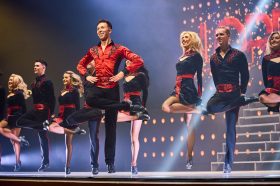Jessica Messenger’s script keeps unpacking surprises. From introducing a sweetly smart pair of best friends, to rolling out quantum mechanic theory and Star Trek references, and then blasting us with some awesome tunes, it turns out to have been an exploration of another dimension entirely, all along.
Naomi is turning 30, her milestone being marked by a surprise party at the local bowls club. Her attentive boyfriend will propose to her, her career is going well, she has a lovely home and her friends and family care enough to turn up for a party on a Monday night. But what if things had turned out differently? What if she had stayed married to her ex-husband and raised lots of organic, free-range Christian children on a farm? What if she had pursued her dream of singing in a speakeasy? Best friend Tegan, PhD candidate in quantum mechanics, provides a framework for Naomi to consider infinitely possible realities. Naomi accuses her of watching too much Star Trek, but Tegan gives the analogy of driving to a set of traffic lights as they turn yellow – as one reality sees Naomi slow and stop, another one is created where she speeds up and drives on through.
The cast are well-matched in terms of dramatic ability, versatility and sharp clean changes between scenes, as well as in terms of vocal talents. The big wow factor in this ensemble lies with the tight harmonies in the various musical numbers that intersperse the dialogue, the quartet’s vocals combining with the simple mellifluous tones of Suzanne Kosowitz’s double bass, highlighting the powerful lead delivery of Erin J. Hutchinson in her various roles.
Hutchinson plays Naomi with sympathetic awareness, taking us on the gradually unfolding parallel trip through Naomi’s emotional truths that are revealed as she flits from one potential existence to another. Hutchinson’s Naomi is believable, likable and worthy of understanding, rather than a panicking bundle of nerves, dissatisfaction and confusion. Best friend Tegan is played by Esther Longhurst, easily taking on the roles of science-obsessed boffin, jazz-aficionado lesbian partner and well-meaning, absent friend with hidden secrets. Nick Maclaine as Robbie and Josh Walker as Jonathan support strongly as interchangeable romantic and friendly interests between realities.
The motif of traffic lights is picked up in Emma Caitlin Brown’s lighting design, the coloured lights providing a navigational aide between Naomi’s realities, clearly marking steps between scenarios. Tessa Darcey makes the most of an elongated set to allow staging of strong tableaux, and designs versatile costuming for Naomi’s rapid changes in circumstances.
Multiverse Theory in D does not play mind games as it steps from one dimension to another, but explores Naomi’s experiences and reactions to every opportunity and difficulty that she encounters, an emotional rather than an intellectual rollercoaster ride. Ellandar presents another work that appeals on many levels, simply designed, cleverly written, and intelligently performed by a well-chosen cast ensemble.
Rating: 4 out of 5 stars
Multiverse Theory in D
Presented by The Blue Room Theatre and Ellandar
Written and directed by Jessica Messenger
Lighting Designer: Emma Caitlin Brown
Set and Costume Designer: Tessa Darcey
Stage Manager: Daley King
Arranger and Double Bassist: Suzanne Kosowitz
Performed by: Erin J. Hutchinson, Esther Longhurst, Nick Maclaine and Josh Walker
The Blue Room Theatre
17 November – 5 December 2015





